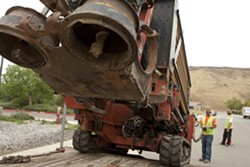Come on baby, light my fiber
A fiber-optic project could be the first step in connecting SLO County to ultra high-speed broadband
By Matt Fountain[{
"name": "Ad - Medium Rectangle CC01 - 300x250",
"id": "AdMediumRectangleCC01300x250",
"class": "inlineCenter",
"insertPoint": "8",
"component": "2963441",
"requiredCountToDisplay": "12"
},{
"name": "Ad - Medium Rectangle LC01 - 300x250",
"id": "AdMediumRectangleCC01300x250",
"class": "inlineCenter",
"insertPoint": "18",
"component": "2963441",
"requiredCountToDisplay": "22"
},{
"name": "Ad - Medium Rectangle LC09 - 300x250",
"id": "AdMediumRectangleLC09300x250",
"class": "inlineCenter",
"insertPoint": "28",
"component": "3252660",
"requiredCountToDisplay": "32"
}]
When Google announced in February 2010 that it was launching a competitive experiment to bring ultra high-speed broadband networks to a small number of trial locations throughout the United States via fiber-optic lines, its intention wasn’t to break into the service-provider business.
The Internet-search giant was attempting to promote awareness of high-speed fiber, test new ways to build fiber networks, and explore the creative potential ultra-high-speed Internet service carries for developers and consumers—the potential, for example, to create new bandwidth-intensive “killer apps” and services and other uses not yet imagined.
This is according to Google Spokesman Dan Martin, who said that beyond the capability to Skype with pristine quality or back up massive files in mere seconds, fiber-optic networks offer significant benefits for the entire community. But don’t take his word for it; the studies are in.
What does the Google Fiber competition have to do with the Central Coast? Rumor has it we didn’t win—Google has promised to announce the lucky community sometime later this year—so why twist the dagger? A local telecommunications firm is awaiting word as to whether it has the green light for a joint public-private project, meaning the federal government may have selected SLO County to be the proud recipient of a hefty grant to craft a fiber-optic infrastructure.
And unbeknownst to most local residents, the area already has one leg up on the competition: The region is the country’s westernmost hub for trans-Pacific fiber lines connecting directly to locations in Asia and Australia.
A national priority
Fiber-optic technology is nothing new in the tech world. After all, beams of light have been shooting through strands of fiber for more than 20 years. What has improved are the electronics that transmit and receive the information at either end.
Underground fiber lines have a lot of advantages over the less effective, soon-to-be obsolete copper wire in use for decades for the same purpose. The most obvious of these advantages is speed. For perspective, the speed of a T-1 connection found in a typical office runs at an average of 1.5 megabits per second (mbps). Fiber connections can run anywhere from 1,000 to 10,000 mbps. They’re not electrical connections, and unlike copper, aren’t susceptible to shortages and outages from moisture. Short of a physical break in the line, fiber can last much longer than copper.
If fiber-optic networks are “the next generation of broadband technology,” as the California Public Utilities Commission (CPUC) contends, most of the country is living in the past. According to an April 2009 report by the Communications Workers of America, the largest communications labor union in the nation, the United States ranks only 28th in the world in average Internet connection speed, with an average connection of 5.1 mbps. In comparison, South Korea leads the world in providing fast and inexpensive Internet access, with an average of 20.4 mbps; followed by Sweden, with 12.8 mbps; and the Netherlands’ 11 mbps, according to the report.
The United States ranks a bit higher in terms of access to broadband service, according to a separate report published in June 2009 by Boston-based analyst firm Strategy Analytics. It ranked the country 20th on the list, with 60 percent of households accessing Internet via broadband. South Korea again led the way with 95 percent. The report attributed South Korea’s dominance, however, in part to its densely urbanized population and strong government-backed broadband policy.
Among those Americans with broadband access, according to a February 2010 Pew Internet and American Life Project study, about one-third of all Internet-consuming households in 2009 had a cable modem (32 percent); another third (30 percent) had a DSL-enabled phone line; and another 11 percent reported a wireless Internet connection. Only 3 percent of families have a fiber-optic connection.
In California, people with broadband access typically get it at lower speeds than does the rest of the country. According to the CPUC, Digitial Subscriber Line (DSL) service, which carries the most limited bandwidth, remains the leading platform for broadband service in the state, while cable modems have been the dominant broadband technology nationally since 2000.
The message is clear, and the government is looking to act. The Federal Communications Commission (FCC) released in March 2010 its National Broadband Plan, which found that approximately 100 million Americans don’t have broadband access at home, and that 14 to 24 million Americans have no access to broadband whatsoever.
The plan, mandated by last year’s stimulus bill, lays out a roadmap for distributing high-speed connections to all Americans—what the FCC calls “the great infrastructure challenge of the 21st Century.” The plan proposed specific methods for forging this new path—among them: reforming current universal service mechanisms to support broadband deployment, ensuring efficient allocation and management of government assets (such as existing government-owned conduits), and supporting overall efforts to boost adoption and use of a high-speed broadband ecosystem.
The feds are a bit behind the curve with their initiative, as several states—including California—have already named expanding comprehensive broadband infrastructure as a top priority. In November 2006, Gov. Arnold Schwarzenegger signed Executive Order S-23-06, which said deploying broadband networks and advanced communication services throughout the state will usher improvements in healthcare, public safety, education, and the economy.
Getting the ball rolling
For almost two years, San Luis Obispo-based data storage and web-hosting company Digital West has been offering fiber-optic connectivity to its business clients. Led by a director of engineering who previously headed a project to wire the war-ravaged east African country of Rwanda from top to bottom, the company’s goal locally is to provide faster speeds to clients with what they call Metro Fiber.
More than a year ago, Grover Beach hired Digital West to develop the city’s technology master plan. As the company was working on that project, the federal government released the American Reinvestment and Recovery Act (ARRA) grants as part of the economic stimulus package passed the year before. Upon learning that federal dollars were available for these kinds of projects, Grover Beach Mayor John Schoals collaborated with Digital West President Tim Williams to apply for a roughly $1.5 million grant. If their request is successful, the money will be used to develop a network that would take advantage of the trans-Pacific fiber-optic landings in their own backyard, the goal being to strategically loop fiber lines throughout the city—and attract businesses and stimulate the local economy in the process. Grover Beach succeeded in getting on the governor’s list of recommended projects, but didn’t make the final cut.
“When [the government] has something like $8 billion, they’re not going to hand out a bunch of $1 million projects—it was too small,” Williams told New Times.
So the company went back to the drawing board, expanding the project to include parts of San Luis Obispo, Arroyo Grande, Pismo Beach, Nipomo, and Oceano, in addition to Grover Beach. This time around, the now-$13 million project has made it past the due diligence phase after the federal government eliminated 80 percent of the applicants.
“Then it was like a month straight of answering questions to the federal government,” Williams said. “The feds were going through every little line, everything we’re going to do.”
After the rigorous Q-and-A, Williams was told the company would get word by the end of September 2010.
Since the trans-Pacific fiber landings are within easy reach, the Central Coast should be an ideal location for businesses working with Asian markets. With latency becoming the buzzword in e-commerce, time saved by sending information directly over the international lines round trip may only be milliseconds, but those milliseconds could possibly make or break a business.
Though Williams points out that the current project doesn’t include hooking up residential consumers with ultra high-speed Internet service, putting the infrastructure in place would make it that much easier to bridge that “last mile” between the network and a neighborhood.
“We want to have this infrastructure in place so that that hurdle, that cost-barrier to us actually providing services, is covered. Then it’s just a matter of getting it from there to homes,” Williams said. “This just gets us that much closer.”
Right now, he explained, simply getting started and helping the customers they can already serve is the company’s goal. Once the project is paid for, the cost of Internet services could eventually decrease, leaving room for healthy competition between incumbent providers.
The last mile
On a damp, foggy Tuesday morning in San Luis Obispo, crews for one of the local exchange carriers in the county, AT&T, began work at their SLO headquarters near Los Osos Valley Road and Foothill Boulevard. The company is putting fiber into San Luis soil, but the aim of the project has nothing to do with bringing higher-speed connectivity to the county.
Instead, AT&T is installing fiber-optic cable in existing AT&T conduits—a process known as overriding—as the northern part of a 242-mile fiber-optic line spanning SLO, Santa Barbara, and Ventura, and terminating in Los Angeles. The company is picking up where it left off after securing county approval in 2002, then postponing the project.
According to Steven McMasters, the project manager and senior planner for the Environmental Division of SLO County’s Department of Planning and Building, this project is about rebuilding AT&T’s own infrastructure with more capacity. It won’t deliver Internet connectivity to local businesses, much less local households.
Why are smaller, local businesses such as Digital West taking the lead in creating a comprehensive fiber-optic infrastructure? Why aren’t larger corporations using their resources to invest in this new technology?
“Broadly speaking, we think providers have made significant and important progress in upgrading their networks over the years, and we understand that much work is being done to expand and improve broadband service nationwide (e.g., FiOS, DOCSIS 3.0)—but there’s more work to be done,” said Google’s Martin in an email.
Williams didn’t answer like a PR rep: “They don’t see the benefit in focusing on our community. Frankly, they have hundreds of communities to choose from, and they’re going to pick the bigger ones where one strand of fiber is going to cover more homes. San Luis doesn’t hit the top of that mark. And if no one is going to push them to do it, they’re not going to.”
A number of studies confirm that private providers are dragging their feet on providing affordable, high-bandwidth service to consumers. In July 2010, for example, the Leichtman Research Group reported that cable TV and phone companies across the nation added 336,000 broadband subscribers between April and June 2010—fewer than any quarter in the last nine years. For the first time, phone companies actually lost a net 7,500 subscribers, while cable companies accounted for the growth.
Getting high-capacity fiber-optic connectivity to a majority of large business customers in smaller metropolitan areas is an expensive investment, but not an impractical one, Williams said.
“We’re finding now that we can put in this fiber-optic technology in densely populated areas,” he said. “Say I put a mile of fiber in the street, I may pass some pretty big buildings with a lot of potential clients. But when you have a not-so-densely populated area, and if you only pass two buildings in that mile, it’s hard to make it pay off. That’s, I think, why we haven’t seen much rapid deployment of this metro fiber.”
A benefit to the entire community
Sure, residential consumers could get faster Internet service at some point down the road, should the Digital West public-private effort succeed in its grant application. But the economic benefits such a venture holds for the entire community promise to be more immediate. After all, infrastructure development is one of the primary ways cities and states make themselves more competitive, an aim that’s more important still in a downtrodden economy. The logic is that if you invest in and build the right thing at the right time, new residents, jobs, and businesses will follow.
Take the fiber-optic project in Ten Sleep, Wyo., a formerly sleepy unincorporated municipality (population: roughly 350) at the base of the Big Horn Mountains. Thanks to a federal subsidy program aimed at connecting rural America to the web, Ten Sleep was able to install high-speed fiber optic lines to every home and business in 2007.
Since then, the tiny town has become a hub for global cyberbusinesses, one of which employs more than 700 people from around northern Wyoming, taking advantage of high-speed capabilities by teaching English via video conferencing to students in South Korea and other parts of Asia.
If the payoff for Ten Sleep was big, how could SLO County take advantage of its unique tele-geography to bolster the local economy?
“Our location gives us the potential for attracting businesses,” Williams said. “These trans-Pacific fiber-optic landings have been here for decades, but they’re still not very well-known—even for people who live here—and there hasn’t been much of a marketing element. But by having this connectivity throughout the county and being able to connect directly to these hubs that take us over to Asia, gives us a little more marketing clout.
“We’re an educated, progressive-thinking community, and this is that type of thing where you can get smart, well-paying jobs from businesses that are interested in locating here. Well, we’re doing it,” he continued. “It’s not going to go to homes at first, but the more we encourage and support our businesses, it’ll be good for everybody. Property values go up if you’ve got this kind of infrastructure. While that doesn’t necessarily benefit [Digital West], as a community it benefits everybody.”
“These three projects would create numerous jobs in our state, and they indicate how California and the federal government, working together and using stimulus funds, can greatly benefit our communities,” CPUC President Michael Peevey said in a January press release. “Moving to quickly approve funding allows California to take advantage of federal stimulus funds, which may bring $225,268,972 to our state.”
Even if the project isn’t approved for the ARRA grant, Digital West will continue to work toward constructing the network—though Williams admitted it will take much longer and cost his company and cash-strapped cities far more money. Asked for a time frame to get started should that be the case, he guessed around three years.
“But if we get the grant, we can put it all together relatively quickly,” he said, with an anxious smile and a nod of the head, “which is going to be a real neat thing.”
Contact Staff Writer Matt Fountain at [email protected].
Latest in News
Readers also liked…
-

Coast Unified teachers upset over new position's salary and qualifications
Oct 20, 2022 -

SLO police identify alleged driver who hit and killed couple
Dec 22, 2022 -

When the levee breaks: Oceano residents, county officials walk a tightrope of regulations to manage Arroyo Grande Creek, which some say led to the levee's failure in January
May 18, 2023










